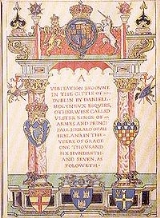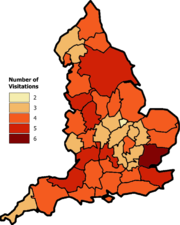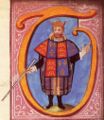
Heraldic visitation
Encyclopedia


King of Arms
King of Arms is the senior rank of an officer of arms. In many heraldic traditions, only a king of arms has the authority to grant armorial bearings. In other traditions, the power has been delegated to other officers of similar rank.-Heraldic duties:...
in England, Wales and Ireland in order to regulate and register the coats of arms
Coat of arms
A coat of arms is a unique heraldic design on a shield or escutcheon or on a surcoat or tabard used to cover and protect armour and to identify the wearer. Thus the term is often stated as "coat-armour", because it was anciently displayed on the front of a coat of cloth...
of nobility and gentry and borough
Borough
A borough is an administrative division in various countries. In principle, the term borough designates a self-governing township although, in practice, official use of the term varies widely....
s, and to record pedigree
Pedigree chart
A pedigree chart is a diagram that shows the occurrence and appearance or phenotypes of a particular gene or organism and its ancestors from one generation to the next, most commonly humans, show dogs, and race horses....
s. They took place from 1530 to 1688, and their records provide important source material for genealogists
Genealogy
Genealogy is the study of families and the tracing of their lineages and history. Genealogists use oral traditions, historical records, genetic analysis, and other records to obtain information about a family and to demonstrate kinship and pedigrees of its members...
.
Process of visitations
By the fifteenth century, the use and abuse of coats of arms was becoming widespread in EnglandEngland
England is a country that is part of the United Kingdom. It shares land borders with Scotland to the north and Wales to the west; the Irish Sea is to the north west, the Celtic Sea to the south west, with the North Sea to the east and the English Channel to the south separating it from continental...
. One of the duties conferred on William Bruges
William Bruges
William Bruges was an English officer of arms. He is best remembered as the first person appointed to the post of Garter King of Arms, which is currently the highest heraldic office in England.-Origins:...
, the first Garter Principal King of Arms
Garter Principal King of Arms
The Garter Principal King of Arms is the senior King of Arms, and the senior Officer of Arms of the College of Arms. He is therefore the most powerful herald within the jurisdiction of the College – primarily England, Wales and Northern Ireland – and so arguably the most powerful in the world...
was to survey and record the armorial bearings
Coat of arms
A coat of arms is a unique heraldic design on a shield or escutcheon or on a surcoat or tabard used to cover and protect armour and to identify the wearer. Thus the term is often stated as "coat-armour", because it was anciently displayed on the front of a coat of cloth...
and pedigrees of those using coats of arms and correct irregularities. The officers of arms
Officer of arms
An officer of arms is a person appointed by a sovereign or state with authority to perform one or more of the following functions:*to control and initiate armorial matters*to arrange and participate in ceremonies of state...
of England made occasional tours of various parts of the country to enquire about matters armorial during the fifteenth century. It was not until the sixteenth century that the process began in earnest.
The first provincial visitations were carried out under warrant
Warrant (law)
Most often, the term warrant refers to a specific type of authorization; a writ issued by a competent officer, usually a judge or magistrate, which permits an otherwise illegal act that would violate individual rights and affords the person executing the writ protection from damages if the act is...
granted by Henry VIII
Henry VIII of England
Henry VIII was King of England from 21 April 1509 until his death. He was Lord, and later King, of Ireland, as well as continuing the nominal claim by the English monarchs to the Kingdom of France...
to Thomas Benolt
Thomas Benolt
Thomas Benolt was a long-serving officer of arms at the College of Arms in London. As part of his service, he was also a diplomat. He appears to have been born at Rouen, though his family had stronger links with Calais. Benolt is thought to have been raised in that city, and his brother at one...
, Clarenceux King of Arms
Clarenceux King of Arms
Clarenceux King of Arms is an officer of arms at the College of Arms in London. Clarenceux is the senior of the two provincial kings of arms and his jurisdiction is that part of England south of the River Trent. The office almost certainly existed in 1420, and there is a fair degree of...
dated 6 April 1530. He was commissioned to travel throughout his province and was given authority to enter all homes and churches. Upon entering these premises, he was authorized to "put down or otherwise deface at his discretion...those arms unlawfully used". He was also required to enquire into all those using the titles of knight
Knight
A knight was a member of a class of lower nobility in the High Middle Ages.By the Late Middle Ages, the rank had become associated with the ideals of chivalry, a code of conduct for the perfect courtly Christian warrior....
, esquire
Esquire
Esquire is a term of West European origin . Depending on the country, the term has different meanings...
, or gentleman
Gentleman
The term gentleman , in its original and strict signification, denoted a well-educated man of good family and distinction, analogous to the Latin generosus...
and decided if they were being lawfully used.
By this writ
Writ
In common law, a writ is a formal written order issued by a body with administrative or judicial jurisdiction; in modern usage, this body is generally a court...
, Henry VIII also compelled the sheriff
Sheriff
A sheriff is in principle a legal official with responsibility for a county. In practice, the specific combination of legal, political, and ceremonial duties of a sheriff varies greatly from country to country....
s and mayor
Mayor
In many countries, a Mayor is the highest ranking officer in the municipal government of a town or a large urban city....
s of each county or city visited by the officers of arms
Officer of arms
An officer of arms is a person appointed by a sovereign or state with authority to perform one or more of the following functions:*to control and initiate armorial matters*to arrange and participate in ceremonies of state...
to give aid and assistance in gathering the needed information. When a King of Arms
King of Arms
King of Arms is the senior rank of an officer of arms. In many heraldic traditions, only a king of arms has the authority to grant armorial bearings. In other traditions, the power has been delegated to other officers of similar rank.-Heraldic duties:...
, or his deputy, visited a county, his presence was proclaimed by presenting the Royal Commission and the local gentry and nobility were required to provide evidence of their right to bear arms. The Sheriff would collect from the bailiff
Bailiff
A bailiff is a governor or custodian ; a legal officer to whom some degree of authority, care or jurisdiction is committed...
of each hundred within his county a list of all people using titles or arms. These were summoned to the visitation and the hope was that none would escape the enquiry. The people that were summoned were to bring their arms, and proof of their right to use the arms. Their ancestry would also be recorded. Where an official grant of arms had been made, this was recorded. Other ancient arms, many of which predated the establishment of the College of Arms
College of Arms
The College of Arms, or Heralds’ College, is an office regulating heraldry and granting new armorial bearings for England, Wales and Northern Ireland...
, were confirmed. The officer would record the information clearly and make detailed note that could be entered into the records of the College of Arms when the party returned to London
London
London is the capital city of :England and the :United Kingdom, the largest metropolitan area in the United Kingdom, and the largest urban zone in the European Union by most measures. Located on the River Thames, London has been a major settlement for two millennia, its history going back to its...
. These volumes now make up the Library of Visitation Books at the College, which contain a wealth of information about all armigerous people from the period. If the officers of arms were not presented with sufficient proof of the right to use a coat of arms, they were also empowered to deface monuments which bore these arms and to force persons bearing such arms to sign a disclaimer that they would cease using them.
The visitations were not popular with the landed gentry who were required to present proof of their gentility. Members of this class grew in power after the installation of William III
William III of England
William III & II was a sovereign Prince of Orange of the House of Orange-Nassau by birth. From 1672 he governed as Stadtholder William III of Orange over Holland, Zeeland, Utrecht, Guelders, and Overijssel of the Dutch Republic. From 1689 he reigned as William III over England and Ireland...
in 1688, and further commissions to carry out visitations were not issued by William or his successors. This cessation of the visitations did not have much effect on those counties far removed from London. Over the period of visitations many of these counties were rarely visited. Those closer to London were more frequently subject to inspection. Also, there was never a systematic visitation of Wales. There were four visitations in the principality, and on 9 June 1551, Fulk ap Hywel, Lancaster Herald of Arms in Ordinary
Lancaster Herald
Lancaster Herald of Arms in Ordinary is an English officer of arms at the College of Arms in London. The title of Lancaster Herald first occurs in 1347 at Calais, and to begin with this officer was a servant to the noble house of Lancaster...
was given a commission to visit all of Wales. This was not carried out, however, as he was degraded and executed for counterfeiting the seal of Clarenceux King of Arms
Clarenceux King of Arms
Clarenceux King of Arms is an officer of arms at the College of Arms in London. Clarenceux is the senior of the two provincial kings of arms and his jurisdiction is that part of England south of the River Trent. The office almost certainly existed in 1420, and there is a fair degree of...
. This is regrettable, since no visitation of all Wales was ever made by the officers of arms.
Surviving records

Harleian Society
The Harleian Society was founded in 1869 for the purpose of publishing manuscripts of the heraldic visitations of the counties of England and Wales, and other unpublished manuscripts relating to genealogy, armory, and heraldry in its widest sense...
, some by county record societies, and a few have been printed privately. Many of the manuscript
Manuscript
A manuscript or handwrite is written information that has been manually created by someone or some people, such as a hand-written letter, as opposed to being printed or reproduced some other way...
s on which these published copies are based can be found today in the British Library in London.
Visitations in Ireland
Since the practices of Ulster King of Arms so closely followed those of the English College of Arms, it is hardly surprising that the Irish officers of arms undertook heraldic visitations in their province. The purpose behind these visitations was twofold: to prevent the assumption of arms by unqualified people, and to record the arms of the gentry that were unknown to Ulster office. The first visitation was held by Nicholas Narbon, the second Ulster King of Arms, in 1569. He was authorized to reform practices which were contrary to good armorial practice. He conducted six visitations (Dublin in 1568–1573, DroghedaDrogheda
Drogheda is an industrial and port town in County Louth on the east coast of Ireland, 56 km north of Dublin. It is the last bridging point on the River Boyne before it enters the Irish Sea....
and Ardee
Ardee
Ardee is a town and townland in County Louth, Ireland. It is located at the intersection of the N2, N52, and N33 roads. Ardee is on the banks of the River Dee and is approximately 20 km from Dundalk, Drogheda, Slane and Carrickmacross...
in 1570, Dublin in 1572, Swords
Swords, Dublin
Swords is the county town of Fingal in Ireland. It is about 13 km north of Dublin city centre and is part of its commuter belt.- History :...
in 1572, Cork
Cork (city)
Cork is the second largest city in the Republic of Ireland and the island of Ireland's third most populous city. It is the principal city and administrative centre of County Cork and the largest city in the province of Munster. Cork has a population of 119,418, while the addition of the suburban...
in 1574, and Limerick
Limerick
Limerick is the third largest city in the Republic of Ireland, and the principal city of County Limerick and Ireland's Mid-West Region. It is the fifth most populous city in all of Ireland. When taking the extra-municipal suburbs into account, Limerick is the third largest conurbation in the...
in 1574). One of his successors, Daniel Molyneux had the commission renewed, and mounted several visitations. Although Molyneux's last visitation–of Wexford
Wexford
Wexford is the county town of County Wexford, Ireland. It is situated near the southeastern corner of Ireland, close to Rosslare Europort. The town is connected to Dublin via the M11/N11 National Primary Route, and the national rail network...
–was the last proper visitation, two other expeditions occurred after 1618 by subsequent Ulster Kings of Arms. The visitations were not very extensive. The officers would not often be found in the disturbed countryside. Thus the visitations are confined to areas under firm control of the Dublin administration.
Today, the original visitation and related manuscripts are in the custody of the Chief Herald of Ireland. Copies are also deposited at the College of Arms in London.
Visitations in Scotland
The 1672 Act of ParliamentAct of Parliament
An Act of Parliament is a statute enacted as primary legislation by a national or sub-national parliament. In the Republic of Ireland the term Act of the Oireachtas is used, and in the United States the term Act of Congress is used.In Commonwealth countries, the term is used both in a narrow...
that created the Public Register of All Arms and Bearings in Scotland
Public Register of All Arms and Bearings in Scotland
The Public Register of All Arms and Bearings in Scotland was established by Act of the Scottish Parliament in 1672. The register is held at the Court of the Lord Lyon and contains every grant of arms since that date. Bearings that are not matriculated in the Register may not be used in Scotland...
gave Lord Lyon King of Arms
Lord Lyon King of Arms
The Lord Lyon King of Arms, the head of Lyon Court, is the most junior of the Great Officers of State in Scotland and is the Scottish official with responsibility for regulating heraldry in that country, issuing new grants of arms, and serving as the judge of the Court of the Lord Lyon, the oldest...
the authority to visit any part of Scotland
Scotland
Scotland is a country that is part of the United Kingdom. Occupying the northern third of the island of Great Britain, it shares a border with England to the south and is bounded by the North Sea to the east, the Atlantic Ocean to the north and west, and the North Channel and Irish Sea to the...
to execute his statutory duties. Such visits have been made in the past, however these visits are not organized information-gathering exercises in specific regions. Scottish heraldry
Scottish heraldry
Heraldry in Scotland, while broadly similar to that practised in England and elsewhere in western Europe, has its own distinctive features. Its heraldic executive is separate from that of the rest of the United Kingdom.-Executive:...
, with its compulsory matriculations, is much more regulated and each generation must lodge an updated genealogy with Lyon Court in order to lawfully bear arms. Therefore the control of heraldry
Heraldry
Heraldry is the profession, study, or art of creating, granting, and blazoning arms and ruling on questions of rank or protocol, as exercised by an officer of arms. Heraldry comes from Anglo-Norman herald, from the Germanic compound harja-waldaz, "army commander"...
in Scotland is such that periodic inspections have never been necessary.
External links
- Heraldic Visitations of Cheshire
- The Harleian Society
- Notes from the visitation of William Fellows, Lancaster HeraldLancaster HeraldLancaster Herald of Arms in Ordinary is an English officer of arms at the College of Arms in London. The title of Lancaster Herald first occurs in 1347 at Calais, and to begin with this officer was a servant to the noble house of Lancaster...
, at CarmarthenCarmarthenCarmarthen is a community in, and the county town of, Carmarthenshire, Wales. It is sited on the River Towy north of its mouth at Carmarthen Bay. In 2001, the population was 14,648....
in 1530: Jones, Francis, The Carmarthenshire Historian, vol. 20, (1985) 65-71.

